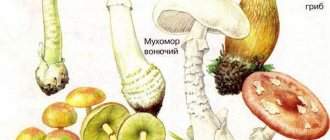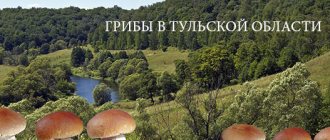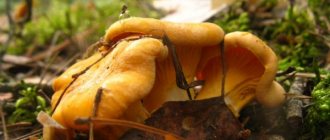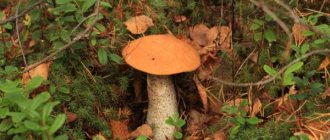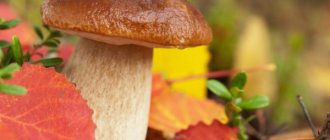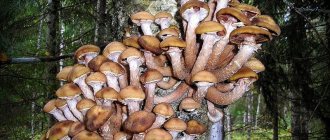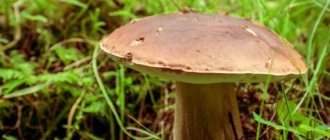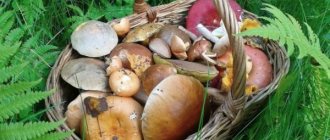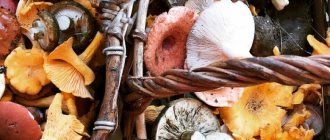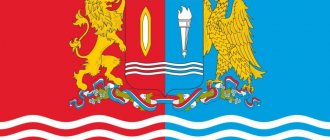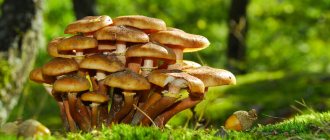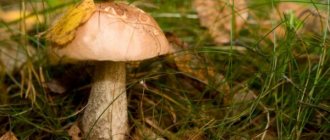Porcini
The porcini mushroom is rightfully considered the king of mushrooms. It is called white mainly because its flesh does not darken after being cut. Another name for boletus mushroom. It belongs to the first category of mushrooms, which means it is absorbed by the body better than other mushrooms. Valued by mushroom pickers for its nutritional properties and excellent taste. Properly prepared porcini mushroom is a real delicacy. In the Yamal taiga, porcini mushrooms are common and if you are lucky enough to find a good clearing, you can easily pick up more than one basket of porcini mushrooms. Porcini mushrooms are used both fresh for frying or boiling, and prepared in the form of pickled, salted or dried mushrooms. Read more about porcini mushrooms.
Edible mushrooms
The main mushrooms of the Urals, found in the north of the Sverdlovsk region, are described.
Boletus
Boletus (aspen, redhead) is a common name for several species of mushrooms of the genus Leccinum (Obabok). They are distinguished by an orange-red (sometimes white) cap and blue flesh of the mushroom when cut. They also usually differ from boletus mushrooms in having a thicker, “stockier” leg and dense cap flesh.
Since all boletuses are edible and almost identical in nutritional quality, mushroom pickers do not always distinguish between their types.
boletus
Boletus is the common name for a group of species of mushrooms of the genus Leccinum (Obabok). They are distinguished by a dim, brownish color of the cap; the flesh is not always colored when cut. They also usually differ from boletuses by having a thinner stem and less dense cap flesh.
All boletus mushrooms are edible mushrooms and differ slightly in nutritional quality.
The name is due to the fact that they often grow near birch trees, because they form mycorrhiza on its roots.
Oil can
Butterfly is a genus of tubular mushrooms of the Boletaceae family.
It got its name because of the oily cap that is slippery to the touch. The characteristic features that distinguish most species of butterfish from other boletaceae are the sticky mucous membrane, the easily removable skin of the cap and the ring remaining from the private cover. Loves to grow along forest roads and paths, as well as along the edges of clearings.
Has a slight laxative effect.
Kozlyak
Kozlyak, reshetnik - tubular mushroom of the genus Butterfly
The diameter of the cap is 3-12 cm, the cap has a convex, cushion-shaped, flat-convex, later flat shape, smooth, sticky, bare to the touch, shiny in dry weather, mucous in damp weather, the color of the cap is reddish-brown, yellowish. brown, light yellow-brown or red-brown, red-ocher. The skin of the cap is not removed or is removed in small pieces.
The pulp is dense, elastic, later rubbery, pale yellow or light yellow in color, in the stem with a tinge of red, brownish or brown, may turn slightly red or pink when cut, tasteless or slightly sour, inexpressive odor. After heat treatment it turns mauve
Gruzd
The real milk mushroom is a mushroom of the Milky genus of the Russula family.
Often referred to as white or wet milk mushroom. The body of the mushroom is fragile; when broken, it releases pungent juice and a specific odor. It is rightfully considered the best mushroom for pickling.
The Milk family also includes dry milk mushrooms, podgruzki, saffron milk caps, volnushki and russula
Russula
Russulas are one of the most common among all the mushrooms of the Northern Urals. They can be found wherever there is a forest.
They begin to grow among the very first mushrooms and continue until late autumn.
Russulas come in a wide variety of colors, from light green to dark purple, but in general the structure of the fungus in all types of russula is very similar. At the beginning, the mushroom cap has a spherical shape, which straightens out very quickly and as it matures, the edges of the cap sometimes even bend upward a little.
In terms of taste and nutritional properties, russulas are slightly inferior to the “valuable” breeds of mushrooms, but they are still very tasty in any prepared form - boiled, fried and especially salted.
These mushrooms should be collected in some kind of hard container (for example, in a basket), since russula are very fragile and when collected in an ordinary plastic bag, there is a high chance of bringing home “porridge.”
The main difference between edible russula and similar poisonous mushrooms is that russulas do not have a “web” on the stem, do not release juice when broken, and often do not have a strong thickening in the lower part.
Ryzhik
Highly valued by many mushroom pickers for their taste, they belong to the first class of mushrooms in terms of nutritional value.
It has several species, but in our forests the following species mainly grow: true camelina, spruce camelina, red camelina.
Red camelina is also valued because it contains an antibiotic that helps in the fight against tuberculosis.
It grows mainly in coniferous forests, occurring more often in dry open places. Very often it is also found in forest clearings, hillsides and the banks of forest reservoirs, where low-growing grass predominates. He also loves paths and trampled places.
It grows from July to October, with spruce saffron milk caps growing most during the period late August - October.
The juice of the mushroom, unlike some other milkweeds, does not have a burning taste, and there is no need to soak the mushroom before cooking. For the same reason, it is suitable for frying and boiling.
Volnushka
It also belongs to the genus Milky, very similar to the saffron milk cap, but in addition to the color, it has the main distinguishing feature - the cap of the moth is covered with many villi, especially at the edges.
It belongs to the conditionally edible mushrooms, but after soaking it can be used in the same way as other mushrooms of this family. The main use is pickling.
(note from the resource administration: in terms of taste, volushka is no worse than other mushrooms, however, it all depends on the ability to cook)
It grows mainly in mixed forests, with the presence of birch, and is often found in damp (but not swampy) places.
Chanterelles
The mushroom has a very memorable shape and has a bright, often orange, color.
The shape of the cap is funnel-shaped, with almost no borders of transition into the stem.
The first mushrooms usually appear in early summer, then reappear in late summer and grow until late autumn.
Usually grows in mixed forests.
Almost all mushrooms of the family are edible or conditionally edible.
There is also
False Fox.
It does not belong to the genus of chanterelles, but nevertheless is a double of the real chanterelle.
Previously considered a poisonous mushroom, but now transferred to the category of conditionally edible,
Despite this, it is not recommended to eat it, as it can cause digestive upset in many people.
It grows from August to November, in coniferous forests, the pulp has an unpleasant odor.
Porcini
It is rightfully considered one of the best mushrooms; it has an excellent taste and smell, but, nevertheless, it is inferior to some types of mushrooms in nutritional value.
The cap grows up to 50cm and the stem 25cm in diameter. When cut and subsequently processed, the flesh of the mushroom remains white, which is why it got its name.
The color of the cap can vary depending on the growing conditions, but usually it is from light brown to dark brown, the stem is thicker towards the bottom.
Interesting facts: the largest porcini mushroom found weighed more than 10 kg and had a cap diameter of 58 cm.
Honey mushrooms
Honey fungus is the common name for several species and families of mushrooms that have a similar appearance and method of growth.
Of all the species, we note those that grow in the Northern Urals:
Autumn honey fungus.
He is also a real honey fungus, has a cap with a diameter of up to 10 cm, less often up to 15, an elongated leg, up to 10 cm long and up to 2 cm in diameter.
They grow in large groups, often fused with legs at the base.
It can grow both on living trees and on rotting remains of trunks and stumps.
The growing season of autumn honey mushrooms begins from the end of August until winter.
This species is loved by many mushroom pickers, although it is classified in some literature as conditionally edible.
Good in any form - fried, boiled, pickled and salted.
Summer honey fungus.
It grows in large colonies mainly on rotten wood of deciduous trees, less often on conifers, but can also be found on damaged living trees.
The cap is convex at first, but with age it becomes almost flat with a clearly visible tubercle in the middle.
The main difference from a similar poisonous mushroom is that there are dark scales on the stem below the ring. Very often grown in artificial conditions.
It grows throughout the warm season.
Honey fungus.
It grows mainly in meadows, clearings, vegetable gardens and other open grassy areas.
The pulp is thin, whitish or pale yellow, does not change color when cut, with a slight sweetish taste and a strong, unique odor reminiscent of cloves or bitter almonds.
Usually only the caps are eaten, since the legs are quite tough.
Contains marasmic acid, active against Staphylococcus aureus and other pathogenic bacteria.
It differs from a similar poisonous mushroom by the presence of a tubercle on the cap and its smell.
Mosswort
Moss mushroom is a genus of tubular mushrooms of the Boletaceae family. It got its name due to the frequent growth of fruiting bodies in moss.
Some taxonomists attribute fungi of this genus to the genus Boletus, which is primarily due to the heterogeneity of the genus Xerocomus.
In terms of taste, fly mushrooms do not stand out much, but perhaps no worse than other mushrooms of this family.
Another disadvantage, from personal experience, is that it is very rarely possible to find non-wormy mushrooms; one gets the feeling that the larvae penetrate them while they are still underground.
Inedible mushrooms
In reality, there are a great many mushrooms classified as inedible or poisonous; in this article we will describe the most famous and common ones.
Death cap
fly agaric
False honey mushrooms
#This is not a finished article
Boletus (Redhead)
He's a redhead, he's an idiot. Valued by mushroom pickers no less than white. Very tasty and beautiful mushrooms. White leg with black dots and a wonderful red or brown cap. It is often found in mixed parts of the Yamal taiga forest and even in the tundra. It grows in families, so if you find one mushroom, there will definitely be more nearby. Redheads are fried, boiled, dried and pickled. Boletus is rich in useful minerals, fiber and carbohydrates. Contains phosphorus, iron, potassium vitamins: A, B, C and PP. The nutritional value of boletus broth is not inferior to meat broth.
Volnushka
Belongs to the genus Milky, lamellar mushrooms. They are conditionally edible mushrooms, but not poisonous. This means that before using the volushka, you need to soak it in water for several hours to remove the bitterness. They like to grow under birch trees, prefers wet, swampy areas. They can be distinguished by their pink cap and short stem. Most often, volushki are pickled or salted. It is best to collect young mushrooms with a small cap for this purpose. During the pickling process, the mushroom changes color from pink to grayish-gray.
Mushroom abundance
Mushrooms of the Arkhangelsk region represent a huge variety. These are edible (russula, aspen, boletus, milk mushrooms, boletus, chanterelles, honey mushrooms, champignons, saffron milk mushrooms, fly mushrooms, boletus, etc.), and inedible (volnushki, bitter mushrooms, nigella, sow mushrooms, gall mushrooms, toadstools, false russula) . They can be found almost everywhere in the forests of the Arkhangelsk region.
By their appearance, edible mushrooms can be easily distinguished from poisonous ones. To avoid mistakes, you need to collect only those that you know well. And if you take unknown specimens, be sure to wash them before you bring them home.
Mushrooms must be handled with care and precision: cut them with a sharp knife so as not to damage the mycelium, and do not tear them out of the ground with part of the stem. Many of them break easily. This especially applies to small species. If you accidentally pull out a mushroom with a fruiting body from the ground, it is best to throw it away.
Gruzd
Another variety of the Milky. Like milk mushrooms, milk mushrooms are conditionally edible, but not poisonous mushrooms. It's all about the presence of acrid bitter juice. But it won’t be difficult to get rid of it by soaking the mushrooms before salting. The breast has a hollow stem and a funnel-shaped cap, usually white. Milk mushrooms have been considered medicinal mushrooms for a long time. Most often they are salted. Salty, crispy milk mushrooms are a real delicacy. Milk mushrooms can carry bacteria that cause botulism, so it is very important to take all precautions when processing and preparing these mushrooms.
Raincoat
Raincoat - there is such a mushroom. It, unlike others, has a completely closed fruiting body, within which numerous spores are formed. There are no poisonous raincoats among them. If they are called that, it means they always appear after rain. The young fruiting bodies of puffballs are edible. They are tasty and nutritious when fried, in broths and soups. When dried and cooked, they retain their white color. In terms of protein content, they are superior even to porcini mushrooms.
Butter
Tubular mushroom. The Butter Dish gets its name from its cap, which looks as if it has been smeared with oil. Delicious edible mushroom. In addition to the oily brown cap, the oiler has a skirt on a leg. Grows in coniferous taiga forests of Yamal. The mycelium is usually very large and if you find one oil can, you will spend a long time on your knees cutting its fellows into a basket. Butterflies are fried and boiled, but these mushrooms are the most delicious when marinated. In addition to its culinary benefits, boletus is also used in folk medicine, for example, to relieve headaches.
Benefits and harms
Forest mushrooms have a number of positive properties. They are nutritious and at the same time low in calories due to their high water content. Therefore, they are useful in dietary nutrition. The presence of vitamins in them strengthens the immune system and increases resistance to viruses.
Some types of mushrooms are used for medical and pharmacological purposes to create new drugs. A number of mushrooms have been used for a long time and successfully in alternative - folk medicine. However, we should not forget that when starting to use any medicine, especially one obtained independently from natural raw materials, you must consult with your doctor. These remedies cannot be the main ones in the treatment of diseases. They are complementary therapy.
To increase plant productivity, a substance obtained from Fusarium is used in the national economy.
But mushrooms also cause harm. Their bodies work like natural sponges and absorb from the environment various toxins released during industrial and agricultural production. In some cases, radioactive isotopes also enter the environment. Therefore, forest organisms should not be collected near populated areas, industrial zones, agricultural concerns, landfills and roads.
Fungal spores are able to penetrate into the most inaccessible places and destroy wood, sleepers, and reduce productivity. In damp rooms, fungi spoil the surfaces of walls and affect food.
Mosswort
A distant relative of boletus and boletus. Some mushroom pickers consider it a weed mushroom because it grows, sometimes in an indecently large number of taiga forests in Yamal. But nevertheless it is an edible mushroom and has a fairly high nutritional value. Moss mushrooms are good for frying and boiling; they are also salted, dried and pickled to serve mushrooms on the winter table. Like damsels, moss mushrooms darken when the cleaned surface comes into contact with air, so they are immediately sent into water. Moss mushrooms contain a lot of vitamins A, B, C, PP and D.
Russula
Another edible lamellar mushroom of the Yamal taiga is russula. This mushroom can be found everywhere, from clearings to swamps. It is believed that the mushroom acquired its name due to the fact that it can be consumed raw. However, it is better not to experiment, but still treat the mushroom before use. Russulas are delicious in a frying pan or in soup, and are also suitable for pickling. Ready for use on the second day after salting. Some types of russula are inedible or conditionally edible, so be careful when collecting this mushroom and eating it.
These are not all the mushrooms growing in the Yamal forests, but these are the main ones, the most delicious and the most valuable.
Subscribe to our Telegram
Skripun
Or a violin . This mushroom got its name from the very squeaking noise that occurs when you rub the cap against the cap of freshly picked mushrooms. Few hunters take them into the basket; they do not want to interfere with other mushrooms. But in vain. This mushroom is not at all as bad as they think it is. The creaking goes mainly to salting. First, the mushroom must be thoroughly boiled in two waters.
Well, recognizing a violin among its relatives is as easy as shelling pears: break off a piece of the cap and immediately milky juice, white as milk, will appear in large drops. If you touch it lightly with the tip of your tongue, it will burn with bitterness.
